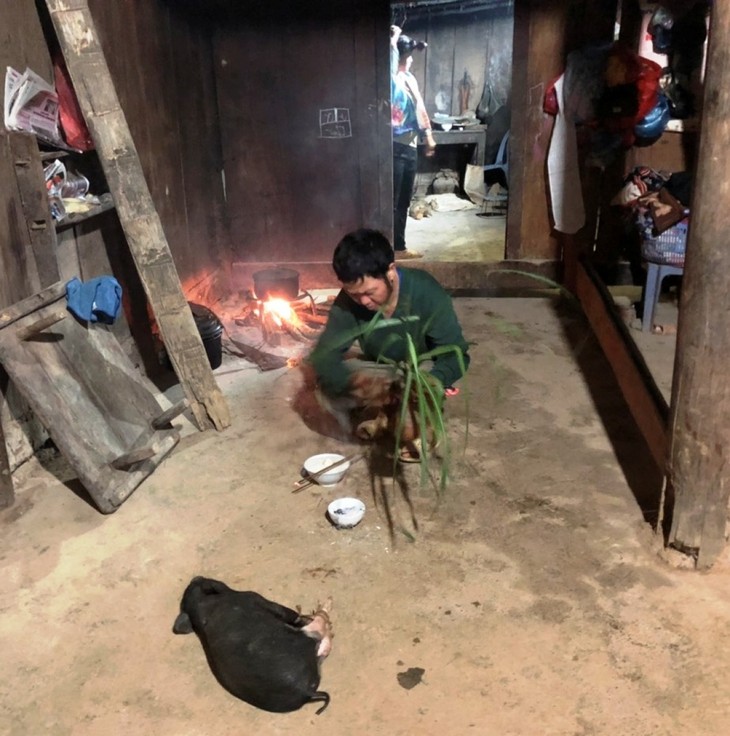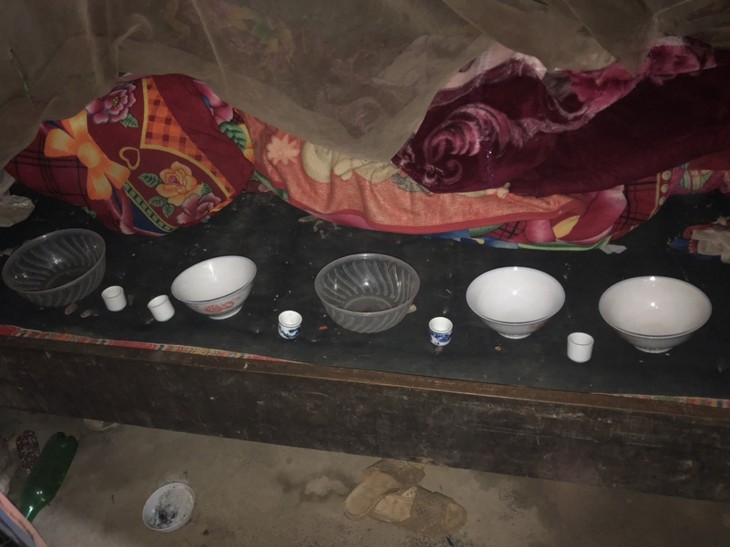(VOVWORLD) - At the beginning of the New Lunar Year, Mong ethnic minority people often organize a sacrifice ceremony to deities. The ritual is particularly held when a family encounters bad luck in business or animal husbandry.
 A shaman explains to the deities the reasons to organize the sacrifice ceremony. (Photo: VOV) A shaman explains to the deities the reasons to organize the sacrifice ceremony. (Photo: VOV) |
Before a sacrifice rite, the householder must prepare three reeds, a flat bamboo basket, a burning firewood log, and a female dog or pig of 10 to 12 kilos and dig a one-meter-deep hole just to the left of the main door inside the house to hold the offerings.
When the offerings are ready, at exactly 7 p.m. the sacrificed dog or pig is placed next to a shaman who stands at the main door to report to the deities and kitchen gods by reading a prayer.
Vu Sua Ly of Son La province, a shaman with broad knowledge of Mong customs, told VOV, “The prayer reports to the deities that the householder has these domestic animals to testify to the family's sincerity and ask them to bless all of the family with good health, luck in cattle and crop farming, and savings.”
When the prayer is completed, the sacrificed animal is given to the young men of the family to slaughter. Part of the animal’s meat is boiled.
The rest of the meat is placed in 5 soup bowls and 5 rice bowls for the second rite. The three reeds and the basket are placed in the family’s main bedroom.
 The soup bowls used for the sacrifice rite are placed in order from the head to the foot of the bed. (Photo: VOV) The soup bowls used for the sacrifice rite are placed in order from the head to the foot of the bed. (Photo: VOV) |
Thao No Cho of Ban Na Ngan hamlet in Son La city said, “The most important part of the sacrifice ceremony is performed in the bedroom of the homeowner.”
“The soup bowls are placed in a row. The animal organs are cut into small pieces. If there are five bowls, each organ is cut into five pieces. The pieces are placed in the bowls in order from the head to the foot of the bed. The last bowl receives the tail of the animal.”
The shaman prepares a soup ladle with which to spoon the broth. The number of prayers depends on the number of bowls used.
After each prayer, the shaman spoons meat broth into the small bowls, which are given to the descendants, including the children, to drink so they will be blessed with good health by the deities and kitchen gods.
Following the prayers, the remaining meat is offered to relatives and others attending the ceremony to eat as they pray for the homeowner and his family to have good health, a prosperous business, and healthy livestock.
When the guests go home, the homeowner rolls the three reeds into a bundle and hangs it from the ceiling of the main room in the house, said Vu Sua Ly of Son La province, adding this is the last step of the New Year sacrifice ceremony.
Sua Ly said, “In a sacrifice ritual, everything is done inside the house. Things can only be brought from outside into the house, but not vice versa.”
“According to the tradition, if you remove things from the house during the ceremony, it will drive away all good luck. After enjoying the offerings, guests who attend the rite must wash their hands with water from a pot placed next to the hole before leaving the house. This blesses the homeowner and his family.”